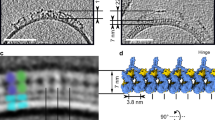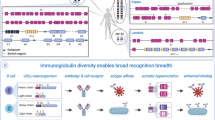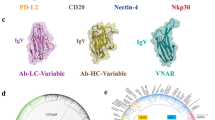Abstract
IT is generally agreed that B-cell surface immunoglobulin (Ig) functions as the receptor for antigen, and so accounts for the specificity of the immune response by clonal selection. It is not known, however, how the combination of surface Ig with antigen stimulates the cell to proliferation and/or differentiation to secrete antibody at a high rate1. A signal could be delivered directly through the receptors, either by an allosteric transition in the receptor itself or by cross-linkage or aggregation of receptor Ig in the fluid cell membrane, analogous to antigen-induced or anti-IgE-induced histamine release from mast cells2. Alternatively, the receptor may act passively as an antigen-specific ‘address’ for the delivery of an antigen-associated nonspecific (that is, potentially polyclonal) signal to some other site on the cell surface3.
This is a preview of subscription content, access via your institution
Access options
Subscribe to this journal
Receive 51 print issues and online access
$199.00 per year
only $3.90 per issue
Buy this article
- Purchase on SpringerLink
- Instant access to full article PDF
Prices may be subject to local taxes which are calculated during checkout
Similar content being viewed by others
References
Greaves, M. F., in Immune Recognition, (edit by Rosenthal, A.), 3–19 (Academic, New York, 1975).
Becker, K. E., Ishizaka, T., Metzger, H., Ishizaka, K., and Grimley, P. M., J. exp. Med., 138, 394–409 (1973).
Coutinho, A., and Möller, G., Scand. J. Immun., 3, 133–146 (1974).
Greenwood, F. C., Hunter, W. M., Glover, J. S., Biochem. J., 89, 114–123 (1963).
Inman, J. K., and Dintzis, H. M., Biochemistry, 8, 4074–4082 (1969).
Molinaro, G. A., Maron, E., and Dray, S., Proc. natn. Acad. Sci. U.S.A., 71, 1229–1233 (1974).
Cunningham, A., and Szenberg, A., Immunology, 14, 599–600 (1968).
Sell, S., and Gell, P. G. H., J. exp. Med., 122, 423–440 (1965).
Maino, V. C., Hayman, M. J., and Crumpton, M. J., Biochem. J., 146, 247 (1975).
Kirchner, H., Oppenheim, J. J., Cell. Immun., 3, 695–699 (1972).
Anderson, J., Edelman, G. M., Möller, G., and Sjöberg, O., Eur. J. Immun., 2, 233–235 (1972).
Greaves, M. F., and Bauminger, S., Nature new Biol., 235, 67–70 (1972).
Feldmann, M., Greaves, M. F., Parker, D. C., and Rittenburg, M., Eur. J. Immun., 4, 591–597 (1974).
Kiefer, H., Eur. J. Immun., 3, 181–183 (1973).
Siraganian, P., Hook, W. A., and Levine, B. B., Immunochemistry, 12, 149–157 (1975).
Feldmann, M., Contemp. Top. molec. Immun., 3, 57–84 (1974).
Möller, G., and Coutinho, A., J. exp. Med., 141, 647–663 (1975).
Nisonoff, A., Wissler, F. C., Lipman, L. N., and Woernley, D. L., Archs biochem. Biophys., 89, 230–244 (1960).
Wofsy, L., Kimura, J., and Truffa-Bachi, P., J. Immun., 107, 725–728 (1971).
Haskill, J. S., and Marbrook, J., Cell. Immun., 13, 12 (1974).
Porath, J., Axen, R., and Ernbach, S., Nature, 215, 1491 (1967).
Gronowicz, E., and Coutinho, A., Eur. J. Immun., 4, 771–776 (1974).
Andersson, J., Bullock, W. W., and Melchers, F., Eur. J. Immun., 4, 715–722 (1974).
Janossy, G., and Greaves, M., Transplant. Rev., 24, 177–236 (1975).
Schimpl, A., and Wecker, E. E., Transplant. Rev., 23, 176–188 (1975).
Dutton, R. W., Transplant. Rev., 23, 66–77 (1975).
Kishimoto, T., and Ishizaka, K., J. Immun., 114, 585–591 (1975).
Author information
Authors and Affiliations
Rights and permissions
About this article
Cite this article
PARKER, D. Stimulation of mouse lymphocytes by insoluble anti-mouse immunoglobulin. Nature 258, 361–363 (1975). https://doi.org/10.1038/258361a0
Received:
Accepted:
Issue date:
DOI: https://doi.org/10.1038/258361a0
This article is cited by
-
B-cell stimulatory factors (BSFs): Molecular structure, biological function, and regulation of expression
Journal of Clinical Immunology (1987)



